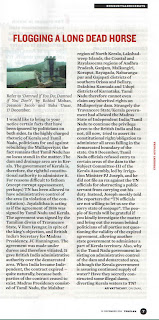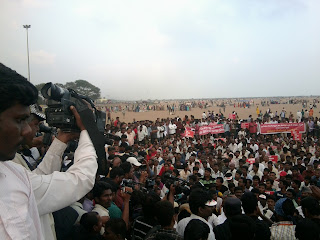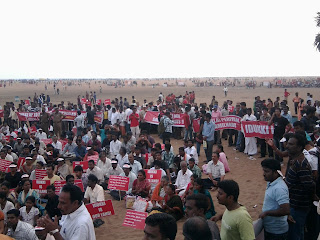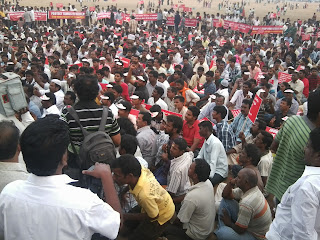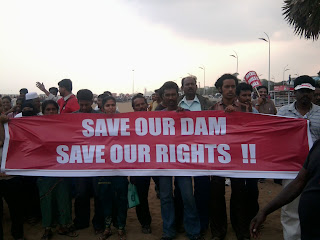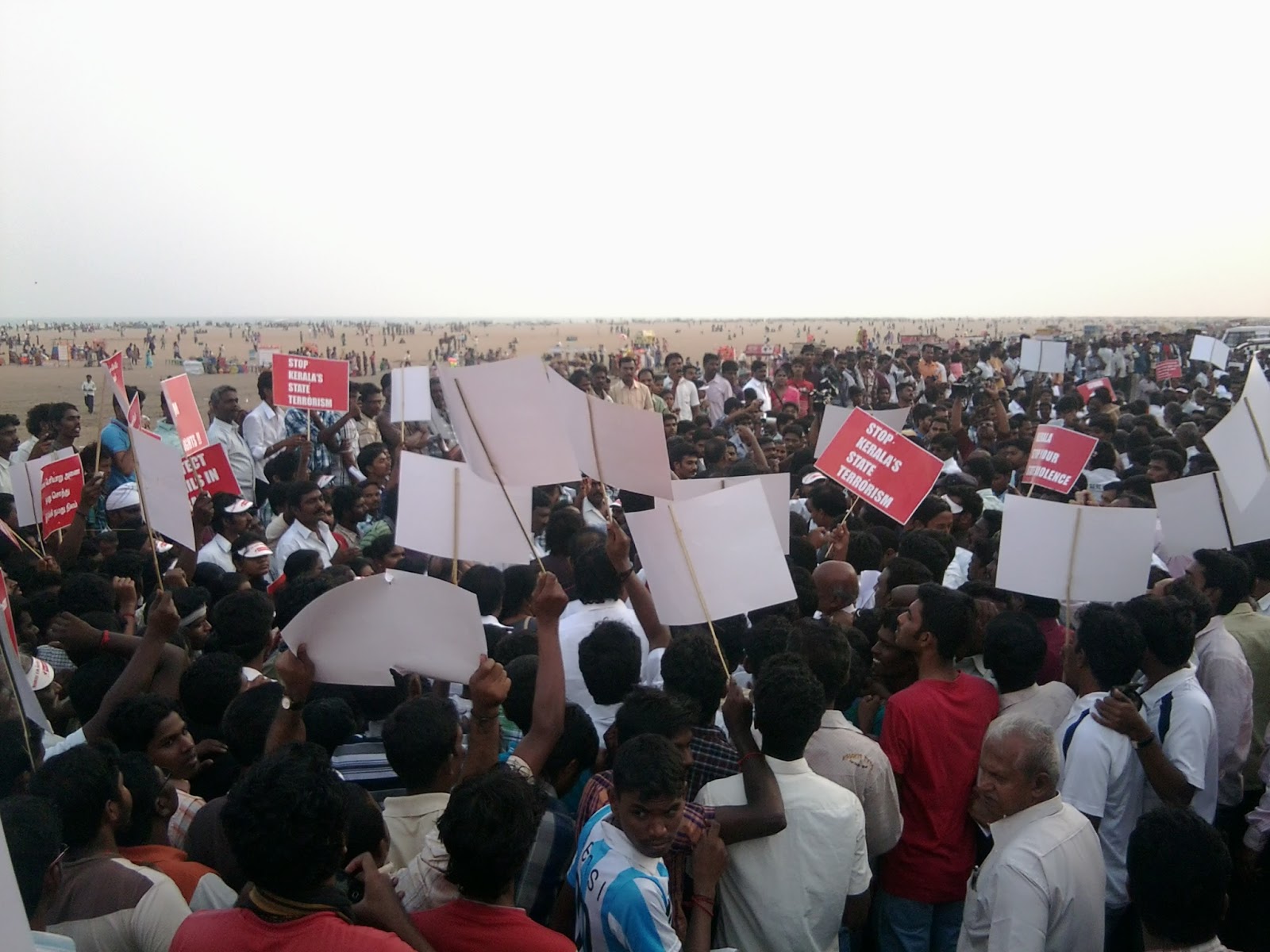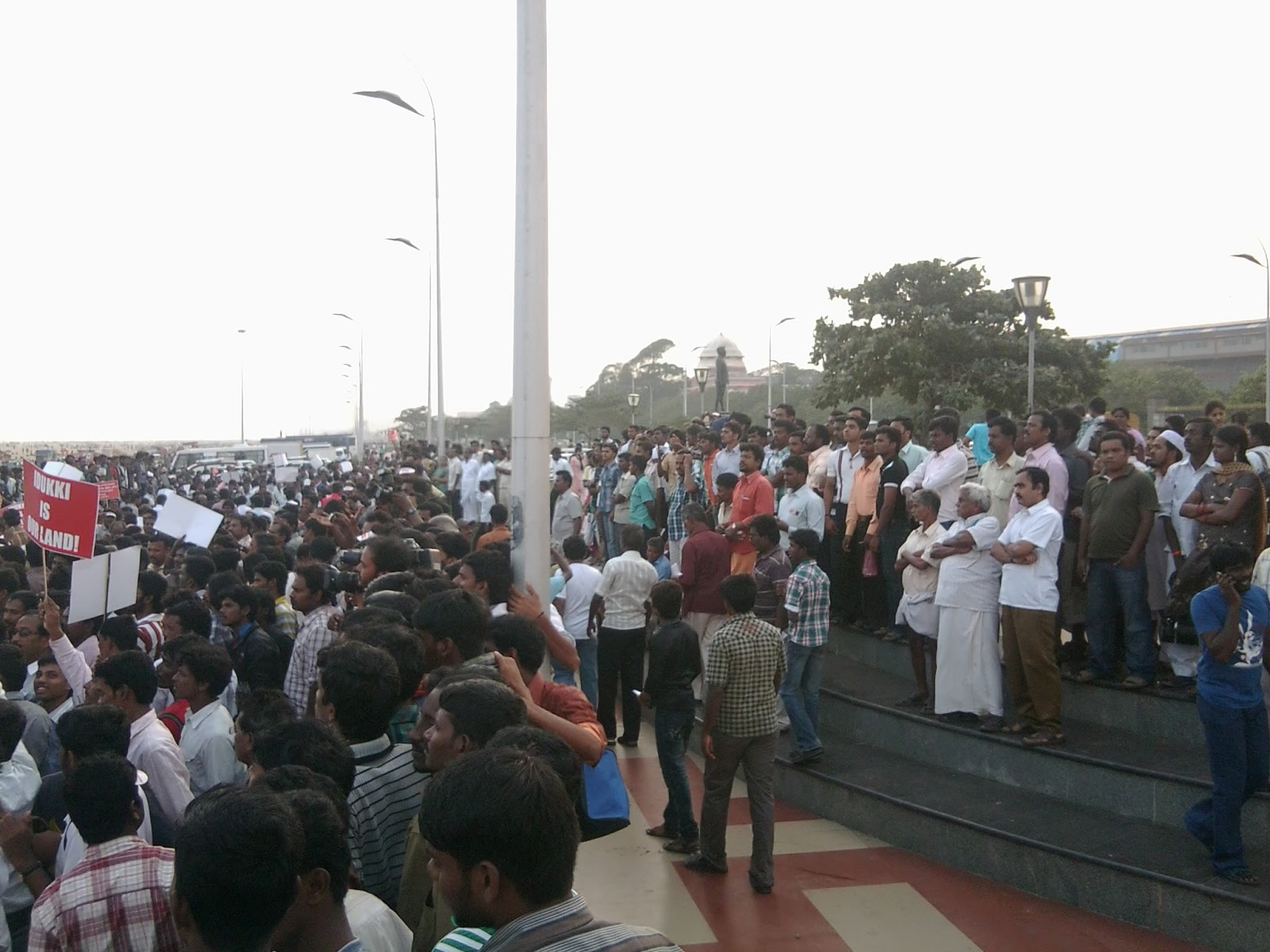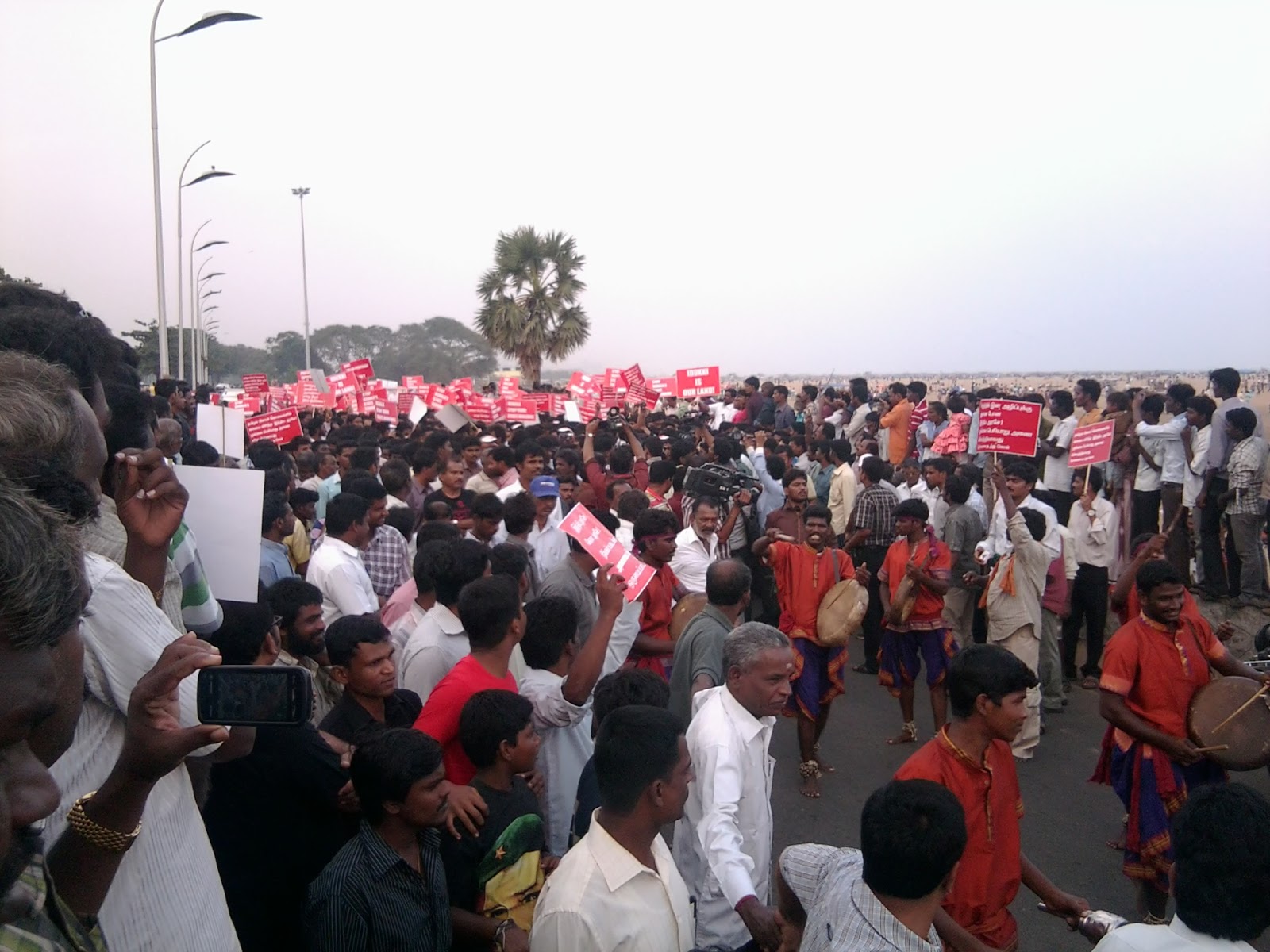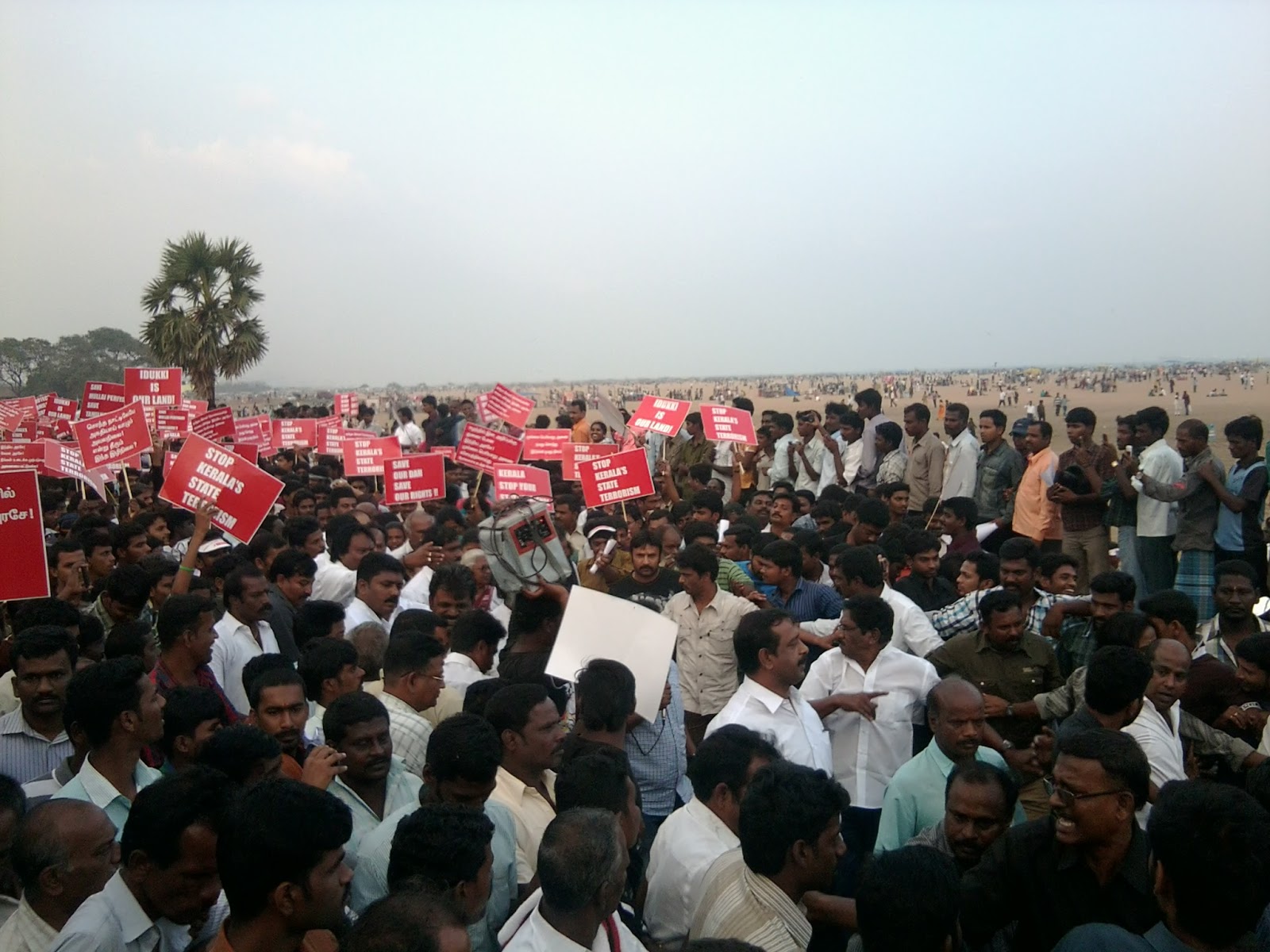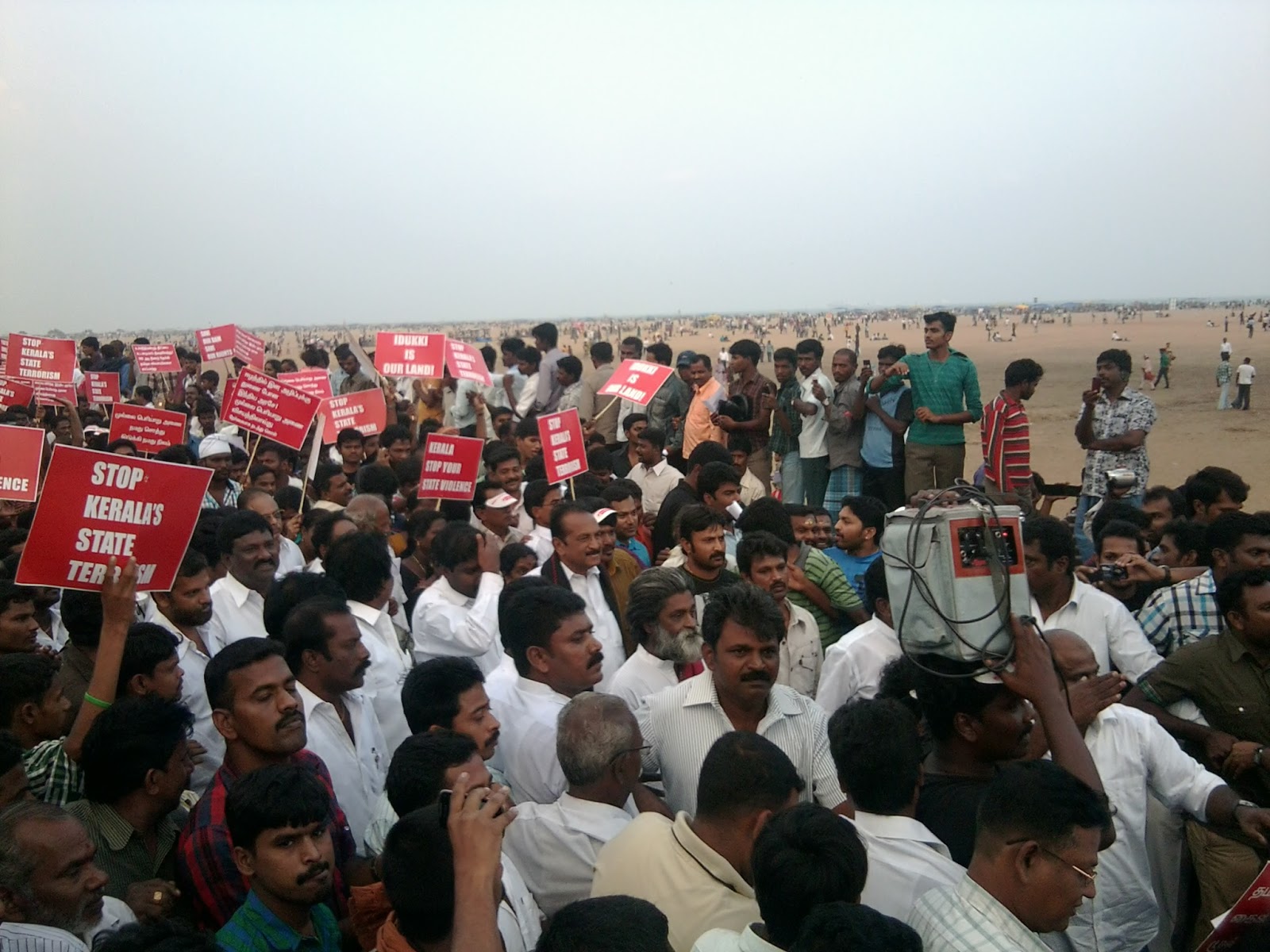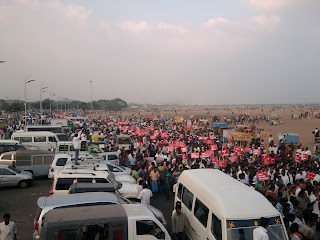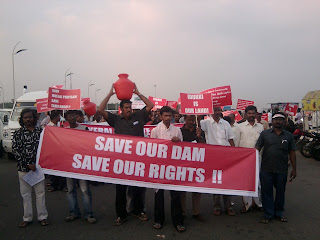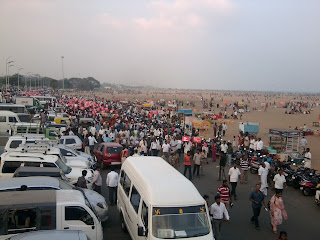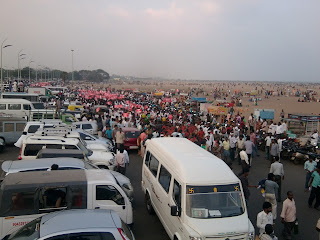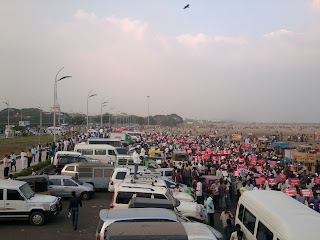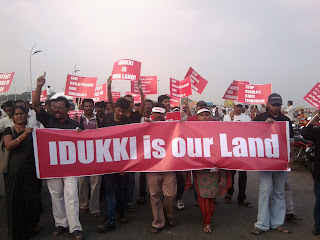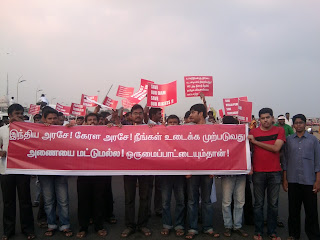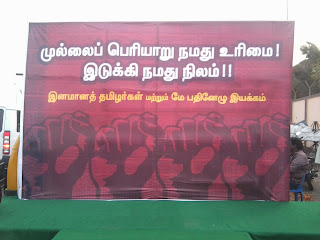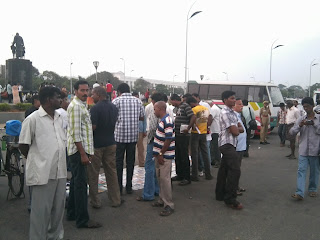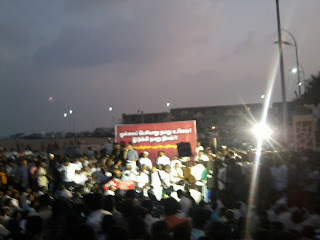முல்லைப் பெரியாறு அணைப் பிரச்சனையில்
இந்து, டைம்ஸ் ஆப் இந்தியா போன்ற ஆங்கிலப் பத்திரிகைகளின்
அப்பட்டமான தமிழர் விரோதப் போக்கும் வெளிப்படையான மலையாளச் சார்பும்
நடுநிலையான ஏடுகள் என்று பிதற்றிக் கொள்ளும் Times of India, The Hindu, Frontline, Tehelka போன்ற ஆங்கிலப் பத்திரிகைகள் முல்லைப் பெரியாறு பிரச்சனையில் தமிழ்நாட்டுக்கு எதிராக தொடர்ந்து கட்டுரைகள் எழுதியும், செய்திகளை வெளியிட்டும் வருகின்றன. சென்னையைத் தலைமையிடமாகக் கொண்ட இந்து'ம் அதன் இருவார இதழான பிரண்ட்லைன்' பத்திரிகையும் தமிழக அரசிடமிருந்து நிறைய சலுகைகளைப் பெற்றுக்கொண்டு, நமது வரிப்பணத்தில் பிழைப்பு நடத்திக் கொண்டு, தமிழர்களுக்கு எதிரான கருத்துக்களை தொடர்ந்து துணிச்சலோடு எழுதி வருகின்றன. நமது வாசகர் தளத்தின் மீது அமர்ந்து கொண்டு, நமது விளம்பரங்களிலிருந்து பெறப்படும் வருமானத்தைக் கொண்டு பிழைப்பு நடத்திக் கொண்டு நமக்குத் துரோகம் செய்து கொண்டிருக்கின்றன.
Times of India, The Hindu ஆகிய இரண்டு நாளேடுகளிலும் (தமிழகப் பதிப்புகளில்), Frontline ஆங்கில ஏட்டிலும் Mullaiperiyar என்று எழுதாமல், திட்டமிட்டே Mullaperiyar என்று (‘i’ இல்லாமல் முல்லா பெரியார்' என்ற தெளிவான மலையாள நிலைப்பாடு எடுத்து) எழுதி வருவதை சற்று கூர்ந்து படிப்பவர்கள் புரிந்து கொள்வர். (அந்த வகையில் முல்லைப் பெரியார் (Mullaiperiyar) என்று சரியாக இந்தியன் எக்ஸ்பிரஸ் ஏட்டில் எழுதப்படுகிறது; கேரளத்தில் தமிழர்கள் மீது நடந்த தாக்குதல்களையும், தமிழ்ப் பெண்கள் மீது நடந்த வன்முறை வெறியாட்டங்களையும் இந்தியன் எக்ஸ்பிரஸ் ஆங்கில ஏடு மட்டுமே பரவலாக பதிவு செய்து வெளியே கொண்டு வந்தது என்பதையும் இங்கே பதிவு செய்ய வேண்டியுள்ளது).
முல்லைப் பெரியாறு அணைப் பிரச்சனையில் தமிழகத்தின் நியாயங்களையும், இங்கு நடக்கின்ற மக்கள் எழுச்சியையும் மறைத்தும், நம் மக்களின் போராட்டங்களை இருட்டடிப்புச் செய்தும், அல்லது வேண்டா வெறுப்பாக சிறு சிறு செய்திகளாக குறுக்கிப் போடுவதுமான வேலைகளை இந்த ஆங்கிலப் பத்திரிகைகள் (தமிழகத்திலிருந்து வெளிவரும் பதிப்புகள்) தொடர்ந்து செய்து வருகின்றன. ஆனால் கேரளாவின் செயல்பாடுகளை அப்படியே நியாயப்படுத்தி எழுதுவதும், அவற்றை பெரிய பெரிய செய்திகளாக்கி தேசிய செய்திகளாக பதிவு செய்வதையும் கண்கூடாகப் பார்க்கிறோம்.
தமிழகத்திலிருந்து வரும் இப்பத்திரிகைகளில் முல்லைப் பெரியாறு அணைப் பிரச்சனையில் நமக்கான அனைத்து நியாயங்கள் இருந்தாலும், தமிழர்களுக்கு எதிராக எழுதுவது குறித்தோ, மலையாளிகளுக்கு ஆதரவாக வெளிப்படையாக கட்டுரைகளை வெளியிடுவது குறித்தோ இந்து, டைம்ஸ் ஆப் இந்தியா போன்ற ஏடுகள் கொஞ்சம் கூட தயக்கம் காட்டுவது இல்லை; வெட்கப்படுவது கிடையாது; கேட்டால் கருத்துச் சுதந்தரம், பத்திரிகைச் சுதந்தரம், சனநாயகம் என்று வாய்கிழியப் பேசுவார்கள். 30 இலட்சம் தமிழர்களின் வாழ்வாதாரத்தை நாசமாக்கும் வேலைக்குத் துணை போவதும், வெறிபிடித்தலையும் கேரள அரசியல்வாதிகளுக்கு வால் பிடிப்பதும் எப்படிக் கருத்துச் சுதந்தரமாகும்?
[
கடந்த பிரண்ட்லைன் ஆங்கில இதழில் (டிசம்பர் 30, 2011) ராமசாமி ஐயர் என்ற ஒரு ஐயனிடமிருந்து மூன்று பக்கப் பேட்டி ஒன்றை பதிவு செய்துள்ளனர். அபத்தமான, தமிழர்களின் வாழ்வாதாரத்திற்கு ஆப்பு வைக்கின்ற, ஆபத்தான கருத்துக்களை அப்படி பேசியுள்ளான் இந்த ஐயன்! தேனி, திண்டுக்கல், மதுரை, சிவகங்கை, இராமநாதபுரம் பகுதியில் உள்ள அனைத்துத் தமிழர்களும் விவசாயத்தை விட்டுவிட்டு வேறு தொழில் செய்ய தயாராக இருக்க வேண்டுமாம்! உடனடியாக இல்லையென்றாலும் பரவாயில்லை; இன்னொரு பத்தாண்டுளில் இப்பகுதி மக்கள் இதற்குத் தயாராகிக் கொள்ள வேண்டும்' என்ற அறிவுரையை முன்மொழிந்துள்ளான்! இதுபோன்ற ஏகப்பட்ட விஷயங்களை (விஷங்களை) முத்தாக பொழிகிறார். அந்தப் பேட்டியை சற்று சுருக்கி இந்து நாளேட்டில் ஒரு கட்டுரையாகவும் (டிசம்பர் 29, 2011) வெளியிட்டுள்ளனர். (பார்க்க: பின் இணைப்பு).
''முல்லைப் பெரியாறு அணை உடைக்கப்பட வேண்டும், புதிய அணை கட்டப்பட வேண்டும்'' என்று மலையாளிகளின் பேட்டிகளையும், அவர்களுக்குச் சாதகமான செய்திகளையும் முதல் பக்கச் செய்திகளாகவும், தேசியச் செய்திகளாகவும் இந்து ஏடு வெளியிடுகிறது. ஆனால் நமது பொறியியல் அறிஞர்கள், அரசியல்வாதிகளின் கட்டுரைகளோ, செய்திகளோ, பதிலுரைகளோ, மாநிலச் செய்திகளாக குறுக்கி வெளியிடுகிறார்கள் அல்லது வெளியிட மறுக்கின்ற போக்கும் நிலவுகிறது. (விதிவிலக்காக, முன்னாள் பொதுப்பணித் துறை அமைச்சர் துரைமுருகனின் கட்டுரை (டிசம்பர் 31, 2011) வெளிவந்துள்ளது. (பார்க்க: பின் இணைப்பு)
இப்போக்கைக் கண்டித்தோ, எதிர்த்தோ தமிழர் நலனில் அக்கறை கொண்டு செயல்படும் கட்சிகள், இயக்கங்கள், மனித உரிமை அமைப்புகள் எதுவும் செய்வதில்லை. நம்முடைய மவுனத்தை சாதகமாகப் பயன்படுத்திக் கொண்டு, வெறிகொண்ட மலையாள ஆங்கில பத்திரிகையாளர்களும், இந்து' ராம் போன்ற பார்ப்பனர்களும் இதைத் தங்கள் பணியாகவே தொடர்ந்து செய்து கொண்டிருக்கின்றனர். ஈழப் பிரச்சனையில் 1½ தமிழர்களைக் கொன்று குவிப்பதை எப்படி நியாயப்படுத்தி எழுதினார்களோ, அதேபோல் முல்லைப் பெரியாறு பிரச்சனையில் இவர்கள் செயல்படுகின்றனர். இதற்கு நாம் ஏதாவது செய்ய வேண்டாமா?
· டைம்ஸ் ஆப் இந்தியா, தி இந்து போன்ற ஆங்கில பத்திரிகைகளின் அப்பட்டமான மலையாளச் சார்பு, தமிழர் விரோத போக்கைக் கண்டித்து, தமிழர் நலனில் அக்கறையோடு போராடும் அனைத்துக் கட்சிகளும், அமைப்புகளும் வெளிப்படையாக அறிக்கைகள் விடவேண்டும்; அவற்றுக்கு பேட்டிகள், செய்தகிள் வழங்குவதைத் தவிர்க்க வேண்டும்.
· இந்தப் பத்திரிகைகளில் மலையாள நிருபர்களின் ஆதிக்கம், தமிழர் விரோத நடவடிக்கைகளைக் கண்டித்து அப்பத்திரிகை அலுவலகங்களுக்கு முன் தொடர்ந்து ஆர்ப்பாட்டங்கள், தர்ணாக்கள் நடத்த வேண்டும்;
· தமிழக அரசு இந்த ஏடுகளுக்குத் தரும் விளம்பரங்கள், சலுகைகளை நிறுத்துமாறு தமிழக அரசுக்கு நிர்பந்தம் தரவேண்டும்;
· முல்லைப் பெரியாறு அணைப் பிரச்சனையில் இந்த பத்திரிகைகளின் மலையாளச் சார்பு பிரச்சாரத்திற்கு எதிராக தமிழக மக்கள் மத்தியில் கருத்துப் பரப்பல் செய்ய வேண்டும். குறிப்பாக, தேனி, விருதுநகர், திண்டுக்கல், மதுரை, சிவகங்கை, இராமநாதபுரம் மாவட்டங்களில் உள்ள விவசாயிகள் சங்கங்கள், மாணவர் அமைப்புகள், இளைஞர் அமைப்புகள், வழக்கறிஞர் சங்கங்கள் மற்றும் தொழிலாளர் அமைப்புகள் போன்றவை மதுரையில் செயல்படும் இந்து, டைம்ஸ் ஆப் இந்தியா பத்திரிகை அலுவலகங்களுக்கு எதிரே அறவழியில் போராட்டங்களை தொடர்ச்சியாக முன்னெடுக்க வேண்டும். இப்பத்திரிகைகளின் அப்பட்டமான தமிழர் விரோத போக்கைக் கண்டித்து நகரங்களிலும், கிராங்களிலும் சுவரொட்டிப் பிரச்சாரம் செய்ய வேண்டும். இப்பத்திரிகைகள் பேசும் ''போலியான நடுநிலைமை'' முகமுடியை நம் மக்கள் முன் கிழித்து எறிய வேண்டும். முல்லைப் பெரியாறு அணையை உடைப்பது சரி' என்று நியாயப்படுத்தும் பத்திரிகைகளுக்கு மதுரையிலும், சென்னையிலும் என்ன வேலை? என்ற பிரச்சாரத்தை வலுவாக மக்கள் மத்தியில் கொண்டு செல்ல வேண்டும்.
· டைம்ஸ் ஆப் இந்தியா பத்திரிகை (சென்னை அலுவலகம்) மலையாளிகளின் ஆதிக்கத்தில் எவ்வாறு இருக்கிறது, தமிழர்கள் நலன்களுக்கான செய்திகள் எவ்வாறு அவ்வலுவலகத்தில் முழுக்க இருட்டடிப்பு செய்யப்படுகிறது என்பதை வெளிப்படையாக ராதிகா கிரி என்ற எழுத்தாளர் The Weekend Leader இணைய இதழில் எழுதியுள்ளார். இதற்கு Times of India ரூ.100 கோடி இழப்பீடு கேட்டு இந்த இணைய இதழின் ஆசிரியர் வினோஜ் குமார் மற்றும் எழுத்தாளர் ராதிகா கிரி மீதும் வழக்குத் தொடுக்கப் போவதாக மிரட்டியுள்ளது. உண்மையைச் சொல்லும்போது மலையாள வெறியர்களுக்கு எவ்வளவு கோபம் வருகிறது!

The Hindu
Two States and a water issue
Ramaswamy R. Iyer
This article seeks to explain the elements of the raging controversy over the Mullaperiyar dam for the information of the general reader. There are four distinct aspects to this case, and these are elucidated below.
(a) Extraordinary nature of the project: This is a project involving the eastward diversion of the waters of a west-flowing river, which has been celebrated as a gigantic feat of 19th century engineering. It was a major intervention in nature of a kind that is no longer much in favour. Was that feat of engineering necessary? Were there no other possibilities of development — less ambitious, less capital-intensive, less damaging to nature and wildlife, more local, less water-demanding — for the water-short districts in the Vaigai Basin? Such questions were probably not asked at the time. EIAs, the assessment of options, etc., are practices that came up much later. Be that as it may, the project was constructed and Periyar waters have been flowing to Tamil Nadu for over a hundred years.
(b) Sense of grievance in Kerala: Under the 1886 agreement between the former Madras Presidency and the princely State of Travancore, Travancore agreed to the diversion of Periyar waters to Madras Presidency, and to lease a piece of land (8000 acres) in its territory to Madras Presidency for building and operating the project designed for this purpose. The curious fact is that the lease was for 999 years. Whole countries and civilisations could have changed during that period! In Kerala, there is an almost universal feeling (right or wrong) that the 1886 agreement was an unfair one imposed on a reluctant Travancore by a more powerful Madras Presidency with the prestige and power of the British government behind it; and that while Madras (now Tamil Nadu) benefited substantially from the agreement, Travancore (Kerala) got little more than a negligible lease-rent for the land leased to Madras. In 1970, an increase in the lease rent was negotiated by Kerala but there was no radical revision of the totality of the agreement. In any resolution of the Mullaperiyar issue, some assuaging of Kerala's longstanding grievance will have to be an element.
(c) The dam safety question and the people's fears: Prima facie , dam safety does not seem a suitable subject for judicial determination. One wishes that the Supreme Court had told the two State governments to resolve the issue by amicable discussions, or to seek the intervention of the Central government. Alternatively, the Supreme Court could have directed the Inter-State Council, a constitutional body, to intervene and bring about an amicable settlement. Instead the learned judges decided to deal with the matter themselves, and appointed an Empowered Committee to examine and report on it. The Empowered Committee includes eminent experts but their opinion, even if the Supreme Court accepts it, may not necessarily be the final word on the subject, particularly if a different opinion is given by other equally distinguished experts outside. Under the circumstances, the sensible course would be for the two State governments, perhaps with the assistance of a joint committee of experts, to reach a reasonable agreement on the subject.
However, no expert can give an absolute guarantee of safety. The dam in this case is 116 years old, and even with all the strengthening measures, one can hardly be wholly confident about its safety under all circumstances. The recent tremors in the area might have been minor but no one can guarantee that a stronger earthquake will not occur, or that if it does the dam will withstand it; or that if there is an exceptionally heavy flood the dam will be safe. These are extreme and perhaps improbable situations but the point is that there can be no absolute unqualified guarantee of safety under all circumstances. That is true of all dams, and particularly so of ageing dams and of dams in seismically active areas.
Moreover, what the experts say may not allay the fears of the people downstream of the dam. To some extent those fears might have been accentuated by the statements of political leaders but they cannot be lightly dismissed as imaginary or paranoid. The people living in the shadow of the dam need to be reassured.
The remote contingency of a risk actually materialising may be acceptable in many cases, but unacceptable in a few. It seems to this writer that the risk in this case falls into the category of ‘unacceptable'.
Having regard to all this, it seems clear that this is a fit case for the application of the Precautionary Principle. This means that the authorities concerned must refrain from putting undue strain on the dam .
A further point is that with strengthening measures, the 116-year-old dam can perhaps be kept going for some more years but it must be presumed to be nearing the end of its useful life. Contingency plans must be prepared for the eventual phasing out of the dam. These must include alternative means of supporting economic activity and prosperity in the project-dependent areas in Tamil Nadu.
The Kerala government wants to replace the old dam by a new dam to be constructed 300 metres downstream. It is not clear that this will enable the continuance of flows to Tamil Nadu. In any case, the old dam itself was a horrendous intervention in nature, but it exists and we have to live with it; but there is no reason why the hubristic engineering of more than a century ago must now be repeated. If Kerala's objective is to escape from what it considers an unfair agreement, the proper course is to re-negotiate the old agreement, and not build a new dam.
(d) The concerns of people in Tamil Nadu: Whatever views one might hold on the nature of the project, the fact is that the people in the water-short Vaigai Basin areas in Tamil Nadu have been recipients of Periyar waters for over a hundred years, and must be presumed to have acquired some kind of a right of established use. The dispute regarding the safety of the dam has created a sense of uncertainty — in fact an acute anxiety — in the areas concerned in Tamil Nadu about continued flows. Thus, there are two vulnerabilities in this case: the life-security concerns of people in Kerala and the livelihood-security concerns of the people of Tamil Nadu. Both need to be addressed.
Pleas to all
Having regard to the foregoing analysis, this writer respectfully makes the following pleas to all:
To the two State governments or to the one concerned:
• tone down the rhetoric; don't take extreme, non-negotiable positions;
• don't build a new dam;
• strengthen the existing dam and operate it safely at a mutually agreed water-level; implement whatever safety measures the experts recommend;
• negotiate changes in the old agreement to remove the continuing sense of unfairness;
• reassure the people in Kerala on safety, and persuade the people in Tamil Nadu to accept a safe water-level behind the dam; bring about an agreement on this through amicable negotiations with the assistance of NGOs, eminent persons, etc;
• recognise that even with strengthening, the 116-year-old dam will not last forever, and plan for its gradual phasing out over a period of time; explore alternative ways of meeting the legitimate water needs of the affected population; minimise their dependence on waters from the Mullaperiyar dam through better water management, changes in cropping patterns, changes to forms of development that need less water, etc. (The Centre should assist Tamil Nadu in such adaptation efforts.)
To the people in both States:
• don't demonise each other;
• recognise each other's vulnerabilities;
• remember that the history has been one of inter-State cooperation and harmony; don't endanger that spirit.
To intellectuals, eminent persons, NGOs, the media, etc, in both States:
• educate public opinion;
• bring the people together; promote understanding and harmony; defuse the current tension.
Reassure the people in Kerala on the safety of Mullaperiyar dam, and persuade the people in Tamil Nadu to accept a safe
water-level behind the dam. Bring about an agreement through amicable negotiations.
=====
The Hindu
Unwarranted fears on Mullaiperiyar
Durai Murugan
Today's Paper » OPINION December 31, 2011
In the latest intensification of the Mullaiperiyar controversy, I see the media discourse not only tilted in favour of Kerala but also seeking to paint Tamil Nadu in a bad light — as an adamant State not concerned about the safety of the people in the neighbouring State. The propaganda by Kerala, which was started way back in 1979 with an article in a Malayalam newspaper, has become so institutionalised now that I see independent experts and activists voicing opinions that fail to take into account Tamil Nadu's considered standpoint.
One of the reasons for the national media overlooking Tamil Nadu's views could be lack of ‘experts', ‘intellectuals', ‘activists', ‘policy-makers' and the like — those who normally contribute erudite articles to the edit and op-ed pages of English newspapers and also appear on television debates — to articulate the State's perspective. But the most important reason is that Mullaiperiyar per se is not an emotive or political issue in Tamil Nadu, which has been treating it as a rights issue that it can solve legally. After all, justice is on the side of the right.
That does not mean that Tamil Nadu has not been responsive to the ‘concerns' that were manufactured with the sole intention of nullifying the State's right over 8000 acres of land that Tamil Nadu holds inside Kerala by virtue of an agreement between the erstwhile Maharaja of Travancore and the British Government in India in 1886. Tamil Nadu has taken several steps over the past three decades to allay the fears of the people in Kerala despite knowing very well that politicians were causing panic by propagating falsehoods.
In this context, I found it amusing when Ramaswamy R. Iyer, in two articles, one in The Hindu and another in its sister publication Frontline , stated: “Let Tamil Nadu and Kerala set up a joint committee and reach a mutual agreement. This is essentially a matter for settlement by amicable agreement, not judicial determination.” When I read his statements that neither the view of the Central Water Commission nor the judgment of the Supreme Court was acceptable, I wondered what locus standi he had to make such a suggestion.
With due respect to his views, let me provide key irrefutable facts to reject his thesis. Mr. Iyer himself should be aware of the fact that several rounds of talks have been held between the two States during the past three decades and all of them failed. The talks were held at different levels. Chief Ministers of the States have discussed the issue; Irrigation Ministers have tried to sort out the differences; Chief Secretaries have attempted to arrive at a solution; and other officials have sat across the table several times, even in the presence of the Union Water Resources Ministry. Does Mr. Iyer think that a mutual agreement is possible even now?
But what is galling is Mr. Iyer's contention that it is not a matter for judicial determination. It is the right of every citizen of this country to seek legal recourse on contentious issues and his or her duty to abide by the ruling of the courts. The fact that the Kerala government has failed to abide by the directions of the Supreme Court of India is something no one is bringing to light in the media discourse.
One example relates to the strengthening of the Mullaiperiyar dam, which needs to be done in three phases — emergency, medium-term, and long-term, as advised by the Central Water Commission. Though the medium level strengthening has been completed, Kerala did not allow Tamil Nadu to raise the water level to 142 feet as per the Supreme Court's directive. But overcoming the obstacles that Kerala threw in the way of carrying out the work was more agonising. When Tamil Nadu wanted to use small explosives to break stones, Kerala objected saying that the noise would disturb wildlife. When Tamil Nadu tried to transport the gravel in lorries, they stopped the vehicles saying the sound would scare the animals. At last, we used donkeys to transport building material.
Now Kerala is refusing to give permission for strengthening the baby dam, which is part of the irrigation system in Mullaiperiyar, and the building of the parapet walls on the main dam, which is essential if Tamil Nadu is to complete the long-term strengthening process. If Kerala's concern is the dam's safety alone, why is it preventing us physically from carrying out the strengthening work? I hope the people of Kerala, if they are really fearful of the dam bursting, would ask this of their rulers. Once the long-term strengthening is done, Tamil Nadu would be legally entitled to store water up to 152 feet. It is pertinent here to record the fact that the Kerala government has steadfastly refused to give a power connection to the small PWD maintenance office located at the dam site.
Another issue raised by Mr. Iyer and some other ‘experts' is that the 1886 agreement is seen as ‘unfair' to Kerala. But has its government ever made an issue of it openly? In the various talks I have participated in, the alleged unfairness of the agreement never cropped up. The land clearly belongs to Tamil Nadu as the agreement of 1886 is legally sound.
There can be no question of Tamil Nadu giving up its rights over Mullaiperiyar. The latest slogan, ‘Water for Tamil Nadu, Safety for Kerala,' is just a deception. The proposal for a new dam downstream, which has caught the fancy of many well-meaning people with no real knowledge of ground realities, is only a ploy to deprive Tamil Nadu of water. The most important element that is missing in this narrative is that Mullaiperiyar waters are not exclusively Kerala's, but an inter-State resource governed by the principles of inter-State rivers.
Let me explain why. First, if a new dam is constructed away — that too, downstream — from the Mullaiperiyar, Tamil Nadu will not be able to draw water and supply it to the rain-shadow districts of Theni, Dindigul, Madurai, Sivagangai, and Ramanathapuram. Secondly, environmental clearance could be an uphill task for the construction of a new structure now, given the latest laws, which might be used as a pretext by Kerala to throw up its hands after knocking off the present dam and thus achieving its goal of diverting the water to Idukki dam for power generation.
Kerala's politicians have never told their people for more than two decades that if the Mullaiperiyar is removed, then only about eight tmcft of water would flow into the Idukki dam, which can hold 73 tmcft water. When the people, who have never had an opportunity to see the dam in the thick reserve forest area, were enlightened that the Idukki dam, which is normally filled only up to half its capacity, would hold the water, the Kerala government machinery floated a theory that Idukki would not be able to withstand the sudden inflow. But even the Kerala Advocate General recently told the court that the water would easily collect in the three dams downstream, including Idukki.
Coming to the bogey of ‘tremors' becoming a common occurrence in the region, I wonder why Kerala is so cavalier about it, if its claims were true. Will not a strong earthquake pull down the Idukki dam, which is also in the same seismic region, and cause more devastation?
Another suggestion by Mr. Iyer that hurt me immensely is that Tamil Nadu should “minimise…[its] dependence on the waters of the Mullaiperiyar dam.” All those who want the dam to be decommissioned or its water level brought down to 120 feet should read the life history of Major John Pennycuick, the British humanist who was moved by the plight of the people after a series of famines that led to starvation deaths and large-scale migration from the rain-shadow region. The dam is an example of an educated man's compassion for the marginalised sections of society that eke out a living tilling the ground.
Let me conclude by stating another truth. Kerala politicians mounted the proverbial tiger on the Mullaiperiyar issue. They cannot dismount now. But we believe in justice and that explains why we never played any obstructionist role in bringing out the truth that the dam would stand firm for many more years to give livelihood to the people in Tamil Nadu.
(The author is a senior DMK leader and has been a Tamil Nadu Minister holding portfolios of the PWD and Water Resources and Law.)
There can be no question of Tamil Nadu giving up its rights over Mullaiperiyar. Its waters are not exclusively Kerala's, but an inter-State resource governed by the principles of inter-State rivers.
=====
Damned if you do, damned if you don’t - Tehelka
Damned if you do, damned if you don’t - Tehelka
http://www.tehelka.com/story_main51.asp?filename=Ne171211Damned.asp#
=====
‘Any dam has a life' - Frontline
http://www.frontlineonnet.com/stories/20111230282613200.htm
